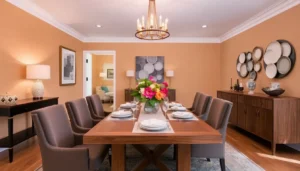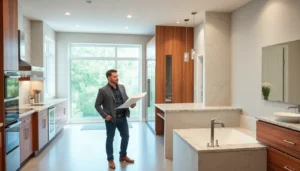Step into a time machine and prepare to be whisked away to the vibrant world of 90s interior design. The living rooms of this era were a delightful mash-up of bold colors, eclectic patterns, and furniture that could double as a piece of art. From oversized couches that practically swallowed you whole to coffee tables that looked like they were plucked straight from a sci-fi movie, the 90s had a flair for the dramatic that’s hard to resist.
Imagine a space where neon greens danced with deep purples and where every knick-knack had a story to tell. Whether it was the iconic bean bag chairs or the unmistakable influence of pop culture, the 90s living room was a playground for creativity. So grab your scrunchies and flannel shirts, because it’s time to explore how this unforgettable decade can inspire today’s home design.
Table of Contents
ToggleOverview Of Living Room 90s Interior Design
Living room design in the 90s showcased vibrant creativity and unique styles. Bold colors like neon greens and deep purples dominated the space, creating a lively atmosphere. Eclectic patterns adorned wallpapers and upholstery, reflecting the era’s diverse tastes. Oversized couches and distinctive coffee tables became staples, emphasizing comfort and style.
Bean bag chairs offered a playful seating option, appealing to both youth and adults. Art pieces, often influenced by pop culture, adorned walls and contributed to the room’s aesthetic. Iconic items, such as VHS cabinets and entertainment centers, reflected the burgeoning home video culture.
Natural light played a significant role in enhancing the warmth of living rooms. Designers incorporated sheer curtains to soften sunlight and create an inviting ambiance. Area rugs with geometric shapes often tied the room’s color schemes together, emphasizing the 90s artistic ethos.
Accessories like potted plants and eclectic artwork increased the room’s character. Retro lamps with unique shapes provided illumination while adding to the design environment. This decade also saw the introduction of multifunctional furniture, catering to smaller living spaces without sacrificing style.
The overall atmosphere in 90s living rooms fostered a sense of individuality and self-expression. Elements of whimsy blended with practicality, making spaces comfortable yet striking. By embracing a mix of influences, homeowners captured the essence of an unforgettable decade that remains influential in modern design today.
Key Characteristics
90s living room designs stand out due to their vibrant aesthetics and unique elements. Creativity flourished, resulting in spaces that emphasized originality and personal style.
Bold Color Palettes
Bright colors dominated the 90s living room. Neon greens, deep purples, and vivid pinks created striking contrasts. Accent walls often featured daring hues, enhancing focal points in the room. Darker shades provided balance, allowing for layers of color. Complementary color schemes added depth, fostering a lively atmosphere. These palettes reflected the exuberance of pop culture and the desire for self-expression.
Patterns and Textures
Eclectic patterns reigned supreme in the 90s interiors. Floral prints, geometric shapes, and abstract designs adorned upholstery and wallpapers. Textured fabrics like velvet and chenille added tactile interest. Layering different designs encouraged a sense of playful chaos while emphasizing individuality. Area rugs often featured bold patterns, anchoring furniture arrangements and tying color schemes together. Accessories included patterned cushions and throws, further enhancing the visual storytelling of each space.
Furniture Styles
The furniture from the 90s features bold and artistic designs that defined living room aesthetics during the decade. Statement pieces dominated, combining comfort with striking visuals to create inviting spaces.
Statement Sofas and Chairs
Statement sofas often showcased oversized silhouettes that invited relaxation. Unique upholstery patterns like vibrant florals or geometric shapes made these couches central to the room’s decor. Chairs such as the iconic bean bag provided a playful nod to casual comfort. Meanwhile, recliners with bold colors added an element of luxury. Each piece highlighted both style and functionality, allowing for personal expression throughout the living space.
Coffee Tables and Entertainment Centers
Coffee tables from the 90s took on diverse forms, varying from sleek glass to rustic wood. Many featured artistic designs that served as conversation starters. Entertainment centers became essential, often housing large televisions and collections of VHS tapes. These centers combined style with practicality, offering ample storage while maintaining a cohesive look. Functionality and aesthetics seamlessly blended, reflecting the era’s focus on multimedia enjoyment in the home.
Decorative Elements
Decorative elements played a vital role in 90s living room design, showcasing the era’s creativity and personal expression.
Wall Art and Posters
Art pieces often featured pop culture icons and vibrant designs. Posters of favorite movies and bands adorned walls, creating focal points that drew the eye. Bold colors and unique graphics reflected the eclectic spirit of the decade. Framed prints added sophistication, while DIY wall art reflected individuality. Styles ranged from abstract to photography, showcasing diverse tastes and interests. Layers of different pieces created a dynamic visual narrative within the space.
Accessories and Lighting
Accessories added character while enhancing the overall design. Potted plants flourished in corners, introducing natural elements and freshness. Retro lamps with geometric shapes provided ambient lighting, making spaces feel inviting. Throw pillows in eclectic patterns complemented sofas, inviting comfort and warmth. Textured blankets added a cozy touch, perfect for relaxation. Unique decorative items, such as vintage clocks and quirky figurines, served as conversation starters. All these elements combined to create a vibrant yet harmonious atmosphere.
Popular Trends from the 90s
90s interior design embraced bold choices, showcasing varied aesthetics that shaped living room spaces. Two significant trends defined this decade: minimalism and maximalism.
Minimalism vs. Maximalism
Minimalism favored clean lines and subdued color schemes. It emphasized simplicity, often seen in the use of neutral tones and uncluttered surfaces. Conversely, maximalism encouraged the bold, featuring vibrant colors and patterns. Eyecatching decor filled spaces, with the layering of textures and designs creating a richly textured environment. This playful chaos allowed for personal expression, transforming living rooms into vibrant reflections of individual tastes.
Technology Integration
Technology gained prominence throughout the 90s, significantly influencing living room layouts. Large televisions became central entertainment pieces, often housed in expansive entertainment centers. The emergence of VHS players and audio systems added another layer of practicality. Cable management systems also grew more common, addressing the organizational challenge of tangled cords. These advancements shaped the way people interacted with their spaces, balancing functionality with aesthetic appeal.
The charm of 90s living room design continues to resonate today. Its vibrant colors and eclectic styles invite creativity and personal expression. By blending bold patterns with unique furniture pieces, this era established a distinctive aesthetic that remains influential in contemporary interiors.
Incorporating elements like oversized couches and playful accessories can transform modern spaces, offering a nostalgic yet fresh approach. As homeowners seek individuality in their designs, the spirit of the 90s provides endless inspiration. Embracing this playful and artistic ethos can create inviting living rooms that reflect personal style and foster warmth.




